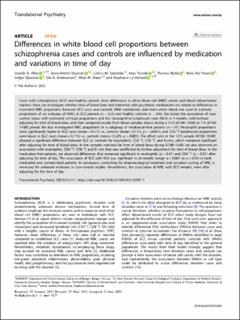| dc.contributor.author | Villar, Jonelle Marie Dickow | |
| dc.contributor.author | Stavrum, Anne-Kristin Støbakk | |
| dc.contributor.author | Nery Spindola, Leticia Maria | |
| dc.contributor.author | Torsvik, Anja | |
| dc.contributor.author | Bjella, Thomas | |
| dc.contributor.author | Steen, Nils Eiel | |
| dc.contributor.author | Djurovic, Srdjan | |
| dc.contributor.author | Andreassen, Ole | |
| dc.contributor.author | Steen, Vidar Martin | |
| dc.contributor.author | Hellard, Stephanie Francoise Claire Le | |
| dc.date.accessioned | 2023-12-01T12:38:54Z | |
| dc.date.available | 2023-12-01T12:38:54Z | |
| dc.date.created | 2023-07-03T10:58:58Z | |
| dc.date.issued | 2023 | |
| dc.identifier.issn | 2158-3188 | |
| dc.identifier.uri | https://hdl.handle.net/11250/3105609 | |
| dc.description.abstract | Cases with schizophrenia (SCZ) and healthy controls show differences in white blood cell (WBC) counts and blood inflammation markers. Here, we investigate whether time of blood draw and treatment with psychiatric medications are related to differences in estimated WBC proportions between SCZ cases and controls. DNA methylation data from whole blood was used to estimate proportions of six subtypes of WBCs in SCZ patients (n = 333) and healthy controls (n = 396). We tested the association of case-control status with estimated cell-type proportions and the neutrophil-to-lymphocyte ratio (NLR) in 4 models: with/without adjusting for time of blood draw, and then compared results from blood samples drawn during a 12-h (07:00–19:00) or 7-h (07:00-14:00) period. We also investigated WBC proportions in a subgroup of medication-free patients (n = 51). Neutrophil proportions were significantly higher in SCZ cases (mean=54.1%) vs. controls (mean=51.1%; p = <0.001), and CD8+T lymphocyte proportions were lower in SCZ cases (mean=12.1%) vs. controls (mean=13.2%; p = 0.001). The effect sizes in the 12-h sample (07:00–19:00) showed a significant difference between SCZ vs. controls for neutrophils, CD4+T, CD8+T, and B-cells, which remained significant after adjusting for time of blood draw. In the samples matched for time of blood draw during 07.00–14.00, we also observed an association with neutrophils, CD4+T, CD8+T, and B-cells that was unaffected by further adjustment for time of blood draw. In the medication-free patients, we observed differences that remained significant in neutrophils (p = 0.01) and CD4+T (p = 0.01) after adjusting for time of day. The association of SCZ with NLR was significant in all models (range: p < 0.001 to p = 0.03) in both medicated and unmedicated patients. In conclusion, controlling for pharmacological treatment and circadian cycling of WBC is necessary for unbiased estimates in case-control studies. Nevertheless, the association of WBC with SCZ remains, even after adjusting for the time of day. | en_US |
| dc.language.iso | eng | en_US |
| dc.publisher | Nature | en_US |
| dc.rights | Navngivelse 4.0 Internasjonal | * |
| dc.rights.uri | http://creativecommons.org/licenses/by/4.0/deed.no | * |
| dc.title | Differences in white blood cell proportions between schizophrenia cases and controls are influenced by medication and variations in time of day | en_US |
| dc.type | Journal article | en_US |
| dc.type | Peer reviewed | en_US |
| dc.description.version | publishedVersion | en_US |
| dc.rights.holder | Copyright 2023 The Author(s) | en_US |
| dc.source.articlenumber | 211 | en_US |
| cristin.ispublished | true | |
| cristin.fulltext | original | |
| cristin.qualitycode | 1 | |
| dc.identifier.doi | 10.1038/s41398-023-02507-1 | |
| dc.identifier.cristin | 2160255 | |
| dc.source.journal | Translational Psychiatry | en_US |
| dc.identifier.citation | Translational Psychiatry. 2023, 13 (1), 211. | en_US |
| dc.source.volume | 13 | en_US |
| dc.source.issue | 1 | en_US |

